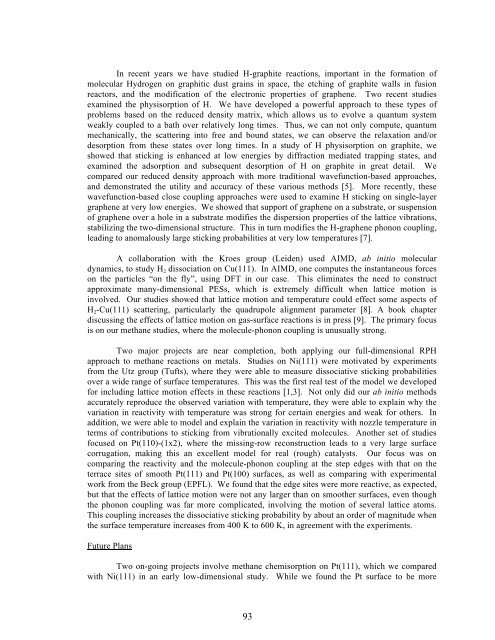Eighth Condensed Phase and Interfacial Molecular Science (CPIMS)
Eighth Condensed Phase and Interfacial Molecular Science (CPIMS)
Eighth Condensed Phase and Interfacial Molecular Science (CPIMS)
You also want an ePaper? Increase the reach of your titles
YUMPU automatically turns print PDFs into web optimized ePapers that Google loves.
In recent years we have studied H-graphite reactions, important in the formation of<br />
molecular Hydrogen on graphitic dust grains in space, the etching of graphite walls in fusion<br />
reactors, <strong>and</strong> the modification of the electronic properties of graphene. Two recent studies<br />
examined the physisorption of H. We have developed a powerful approach to these types of<br />
problems based on the reduced density matrix, which allows us to evolve a quantum system<br />
weakly coupled to a bath over relatively long times. Thus, we can not only compute, quantum<br />
mechanically, the scattering into free <strong>and</strong> bound states, we can observe the relaxation <strong>and</strong>/or<br />
desorption from these states over long times. In a study of H physisorption on graphite, we<br />
showed that sticking is enhanced at low energies by diffraction mediated trapping states, <strong>and</strong><br />
examined the adsorption <strong>and</strong> subsequent desorption of H on graphite in great detail. We<br />
compared our reduced density approach with more traditional wavefunction-based approaches,<br />
<strong>and</strong> demonstrated the utility <strong>and</strong> accuracy of these various methods [5]. More recently, these<br />
wavefunction-based close coupling approaches were used to examine H sticking on single-layer<br />
graphene at very low energies. We showed that support of graphene on a substrate, or suspension<br />
of graphene over a hole in a substrate modifies the dispersion properties of the lattice vibrations,<br />
stabilizing the two-dimensional structure. This in turn modifies the H-graphene phonon coupling,<br />
leading to anomalously large sticking probabilities at very low temperatures [7].<br />
A collaboration with the Kroes group (Leiden) used AIMD, ab initio molecular<br />
dynamics, to study H 2 dissociation on Cu(111). In AIMD, one computes the instantaneous forces<br />
on the particles “on the fly”, using DFT in our case. This eliminates the need to construct<br />
approximate many-dimensional PESs, which is extremely difficult when lattice motion is<br />
involved. Our studies showed that lattice motion <strong>and</strong> temperature could effect some aspects of<br />
H 2-Cu(111) scattering, particularly the quadrupole alignment parameter [8]. A book chapter<br />
discussing the effects of lattice motion on gas-surface reactions is in press [9]. The primary focus<br />
is on our methane studies, where the molecule-phonon coupling is unusually strong.<br />
Two major projects are near completion, both applying our full-dimensional RPH<br />
approach to methane reactions on metals. Studies on Ni(111) were motivated by experiments<br />
from the Utz group (Tufts), where they were able to measure dissociative sticking probabilities<br />
over a wide range of surface temperatures. This was the first real test of the model we developed<br />
for including lattice motion effects in these reactions [1,3]. Not only did our ab initio methods<br />
accurately reproduce the observed variation with temperature, they were able to explain why the<br />
variation in reactivity with temperature was strong for certain energies <strong>and</strong> weak for others. In<br />
addition, we were able to model <strong>and</strong> explain the variation in reactivity with nozzle temperature in<br />
terms of contributions to sticking from vibrationally excited molecules. Another set of studies<br />
focused on Pt(110)-(1x2), where the missing-row reconstruction leads to a very large surface<br />
corrugation, making this an excellent model for real (rough) catalysts. Our focus was on<br />
comparing the reactivity <strong>and</strong> the molecule-phonon coupling at the step edges with that on the<br />
terrace sites of smooth Pt(111) <strong>and</strong> Pt(100) surfaces, as well as comparing with experimental<br />
work from the Beck group (EPFL). We found that the edge sites were more reactive, as expected,<br />
but that the effects of lattice motion were not any larger than on smoother surfaces, even though<br />
the phonon coupling was far more complicated, involving the motion of several lattice atoms.<br />
This coupling increases the dissociative sticking probability by about an order of magnitude when<br />
the surface temperature increases from 400 K to 600 K, in agreement with the experiments.<br />
Future Plans<br />
Two on-going projects involve methane chemisorption on Pt(111), which we compared<br />
with Ni(111) in an early low-dimensional study. While we found the Pt surface to be more<br />
93
















